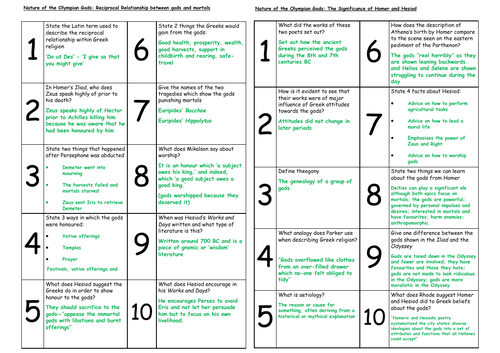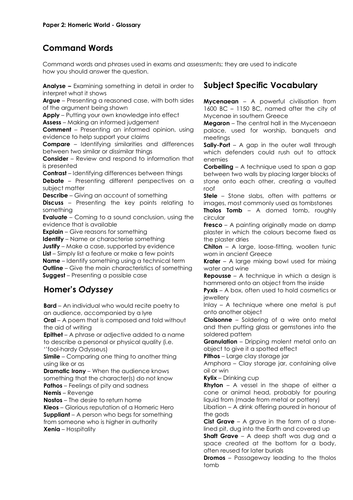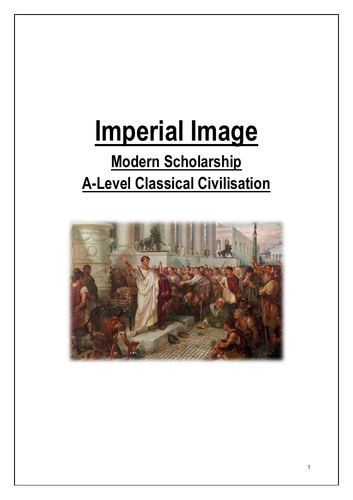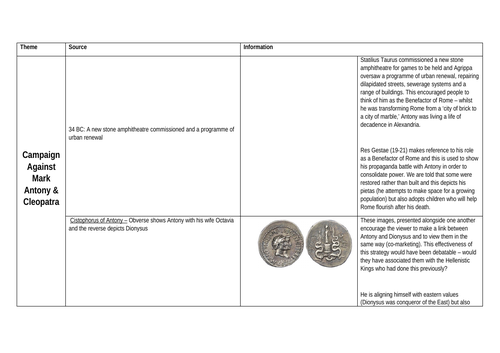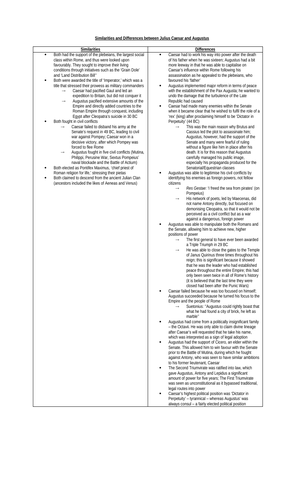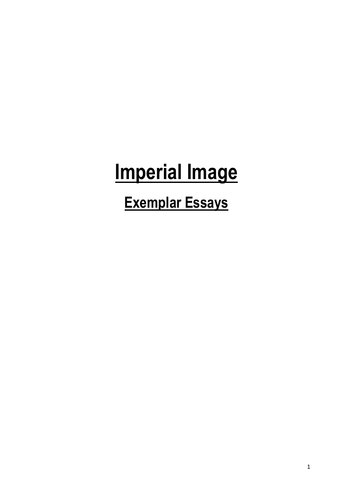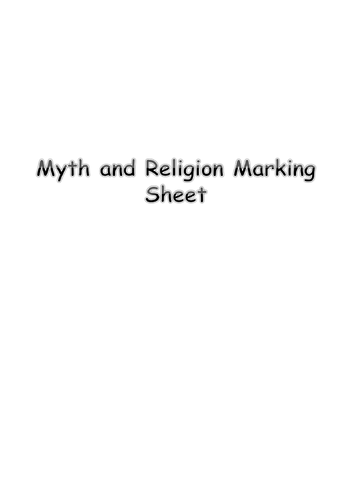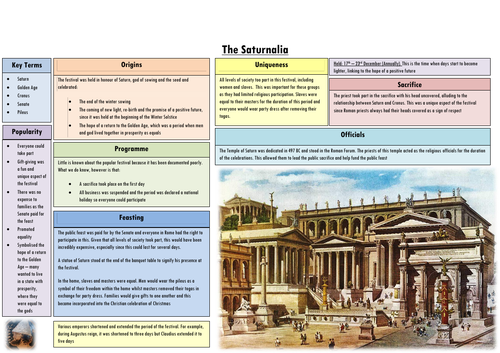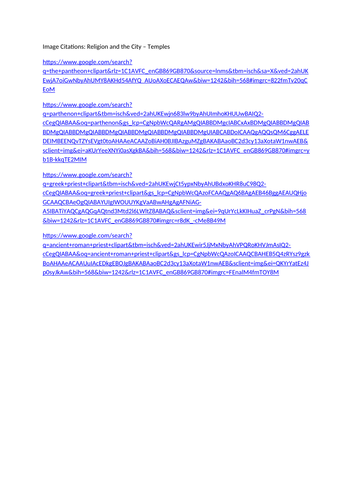
200Uploads
79k+Views
46k+Downloads
Classics
Bundle

Imperial Image Knowledge Organisers/Revision Placemats
Knowledge organisers/revision placemats designed for the OCR AS/A-Level Classical Civilisation specification for ‘Imperial Image.’
These cover sections 1-4 (excluding 5 - Later Representations):
Octavian Comes to Rome
Power Struggle
Augustus’ Reign
Augustus’ Legacy

OCR Classical Civilisation Homeric World (Mycenae, Literature and Culture) (9-1) Revision Guide
Full revision guide for all of the culture section for the Homeric World (J199/21), covering the Mycenaean Age.
The following revision guide has been designed for the OCR GCSE specification for Classical Civilisations:Homeric World. It includes summaries of all topics covered in the four topics as condensed revision notes, with relevant prescribed sources. The 18-page long document provides revision notes for:
Key Sites
Life in the Mycenaean Age
Decorative Arts
Tombs, Graves and Burials
At the end of each section, there is a glossary of key terms. Towards the end,there is an overview of the question types found within the examination (Section A only)

OCR Classical Civilisations: Greek Religion Revision Guide
The following revision guide has been designed for OCR Classical Civilisations: Greek Religion and is intended for the use of A-Level students. It covers all six sections of the course:
Nature of the Olympian Gods
Personal Experience of the Divine
Religion and Society
Places of Worship
Rituals and Priests
Religion and Philosophy
Exam Overview
Example Essay Questions that are listed from previous exam papers which students can complete
Glossary
Key Individuals
It has been attached as both a PDF and Word Document

Greek Religion Revision Quizzes: OCR A-Level Classical Civilisations
Greek Religion (OCR Classical Civilisations) - a set of revision quizzes which cover the whole of the course.
Each quiz has a set of 10 questions (with one containing five questions) which cover a previous one/two lessons. Designed to be used as part of retrieval practice for A-Level students. They can be used as a bell-task activity or as part of revision, allowing students to consolidate their knowledge on previous lessons before moving forward and make links to the wider context.
245 facts can be learnt through completing these quizzes!
This resource also contains answers to all quizzes.
They are tagged together, with titles at the top to make storage easy.

GCSE Classical Civilisations: Exam Command Words and Subject Specific Vocabulary (Homeric World)
GCSE Classical Civilisations exam command words and subject specific vocabulary (OCR) for Paper 2: 'Homeric World)

‘Odysseus is never made to feel welcome on his travels.’
The following answer scored 18 out of 20 marks and is focused on the concept of xenia throughout Odysseus’ travels in Homer’s Odyssey. It can be used as an example essay after mocks or as a source of revision for students hoping to attain higher grades, intended to be used by AS/A-Level students studying the OCR Classical Civilisation ‘World of the Hero’ specification.

Virgil's Aeneid: Theme and Character Sheets
The following documents consist of a break-down of all the key themes found within the epic and of the characters. Quotes are found alongside analysis of passages, with supporting scholarship where appropriate. These have been designed for ‘The World of the Hero’ Paper (OCR: A-Level Classical Civilisation).
Themes that are included:
Moral values implicit in the Aeneid (including pietas and furor)
Importance of Fate and Destiny
Portrayal of War
Portrayal of Different Nations
Role of the Immortals
Family
Friendship
Relationship between Mortals and Immortals
Relationships between Men and Women
Relationships between Parents and Children
Role of Women (and their position in society)
Historical and Political Context (Promotion of Augustus, Promotion of the Roman Empire, Augustus’ rise to power)
NB: David West’s translation has been used when creating this document
Bundle

AS/A-Level OCR Classical Civilisations - Imperial Image Revision Bundle
A bundle of resources for the OCR Classical Civilisation AS/A-Level specification for ‘‘Imperial Image’’.
This bundle contains:
A detailed revision guide
Exemplar Answers
A fill-in revision guide
Revision quizzes that cover the whole course (with answers)
Knowledge Organisers
Summary Notes Revision Booklet
Mindmaps
Timeline
Scholarship
Literary Sources Annotations + Visual Sources Themed Grids
Knowledge Organisers/Revision Placemats (topics 1-4)

Imperial Image: Modern Scholarship (OCR A-Level Classical Civilisations)
An eight-page document providing relevant scholarly views for:
Octavian Comes to Rome
Power-Struggle
Augustus’ Reign
Augustus’ Legacy and Later Representations
Augustus and the Imperial Family
Relevant prescribed sources
This can be easily adapted so that you can add or remove relevant pieces of scholarship. There is space for annotations too

Imperial Image: Prescribed Visual and Literary Sources Grid (OCR A-Level Classical Civilisations)
A breakdown of all prescribed visual and literary sources into relevant themes (see below) for the OCR A-Level Classical Civilisation Specification for ‘Imperial Image,’ intended for the use of AS/A-Level students.
The themes included are:
Religious Leader
Relationship with Julius Caesar
Pater Patriae
Legacy and Later Representations
Imperial Family
Imperator
Image in the Empire
Golden Age
Divi Filius
Cultural Hero
City of Rome
Campaign against Mark Antony and Cleopatra
This document is intended to highlight the sources which would be most relevant to include in essay questions, particularly the short-essay and extended response.

Similarities and Differences between Julius Caesar and Augustus
A comparative list of differences between Julius Caesar and Augustus (Octavian). Useful for when studying the OCR Specification for ‘Imperial Image’ (Topic 1 - Octavian Comes to Rome).

Exemplar Essays: Imperial Image (OCR A-Level Classical Civilisation)
A collection of 13 high-attaining essays written for OCR’s A-Level specification for ‘Imperial Image’ (designed to be used by A-Level students, but can easily be adapted for the use of AS-Level students).
This document consists of:
4 x 10 mark stimulus questions
4 x 20 mark short-essay response questions
5 x 30 mark extended-essay response questions, including use of scholarship
Completed Essay Plan Booklet

OCR Classical Civilisation Revision Notes - Imperial Image
Condensed revision notes for the whole of the OCR A-Level Classical Civilisation specification for ‘Imperial Image.’
Seperated topic by topic, covering:
Octavian Comes to Rome
Power Struggle
Augustus’ Reign
Augustus’ Legacy
Later Representations
Easy to learn, concise, bullet point revision notes
Based on the endorsed OCR textbook
Also includes some exam questions from past papers as well as the textbook with points that could be made in responses.

Myth and Religion (OCR GCSE Classical Civilisations) Marking Sheet/Grid
A simple one page document with the assessment criteria for the OCR GCSE Classical Civilisation specification.
The mark-scheme for all relevant essay questions is broken down into squares with the relevant marks that can be highlighted/circled and for stimulus and extended response questions, there is additional space for any further comments/skills to work on as well as well as a space for personal improvements in addition to teacher comments.
Can be completed digitally and then stuck in during responding to feedback or by hand.
Ideal for responding to feedback.
Bundle

GCSE OCR Classical Civilisations - Myth and Religion Revision Bundle
A bundle of resources for the OCR Classical Civilisation GCSE specification for ‘‘Myth and Religion’’.
This bundle contains:
A detailed revision guide
Exemplar Answers
Revision Checklist
A fill-in revision guide (40 pages long).
21 revision quizzes that cover the whole course (with answers)
Knowledge Organisers
Summary Notes Revision Booklets
Bundle

OCR GCSE Classical Civilisations: Myth and Religion Knowledge Organisers
This bundle contains knowledge organisers covering 1.1 - 1.8 of the GCSE Classical Civilisations specification for ‘Myth and Religion.’ Each consists of a series of condensed revision notes
Easy to learn, concise, bullet point revision notes
Based on the endorsed textbook for the course

Death, Burial and the Underworld Knowledge Organiser - GCSE Classical Civilisations
This knowledge organiser groups together 1.7 and 1.8 of the GCSE Classical Civilisation specification for Myth and Religion and covers Death, Burial and the Underworld.
It provides an overview of the following:
Greek funerary practices, including the prothesis and ekphora
Festivals for the dead ancestors
Funeral Clubs
Roman funerary practices
Homeric Hymn to Demeter
Orpheus and Eurydice

Myth and Symbols of Power Knowledge Organiser - GCSE Classical Civilisations
This knowledge organiser has been designed for students studying OCR’s GCSE Specification for Myth and Religion and covers 1.6 ‘Myth and Symbols of Power.’ It provides an overview of:
Centuaromachy
Amazonomachy
Augustus
Prima Porta
Ara Pacis

Festivals Knowledge Organisers - GCSE Classical Civilisations
These knowledge organisers has been designed for students studying OCR’s GCSE Specification for Myth and Religion and covers 1.5 ‘Festivals.’ There is one knowledge organiser/revision placemats for all four prescribed festivals:
The Panathenia
The City Dionysia
The Lupercalia
The Saturnalia

Religion and the City, Temples: Knowledge Organiser - GCSE Classical Civilisations
This knowledge organiser has been designed for students studying OCR’s GCSE Specification for Myth and Religion and covers 1.3 'Religion and the City: Temples.’ It provides an overview of:
The importance of the sanctuary
Sacrifices
Greek Priests
Roman Priests (Pontifices, Augurs and the Vestal Virgins)
Temple Buildings (Greek and Roman)
Parthenon
Temple of Zeus at Olympia
Temple of Portunus
The Pantheon




